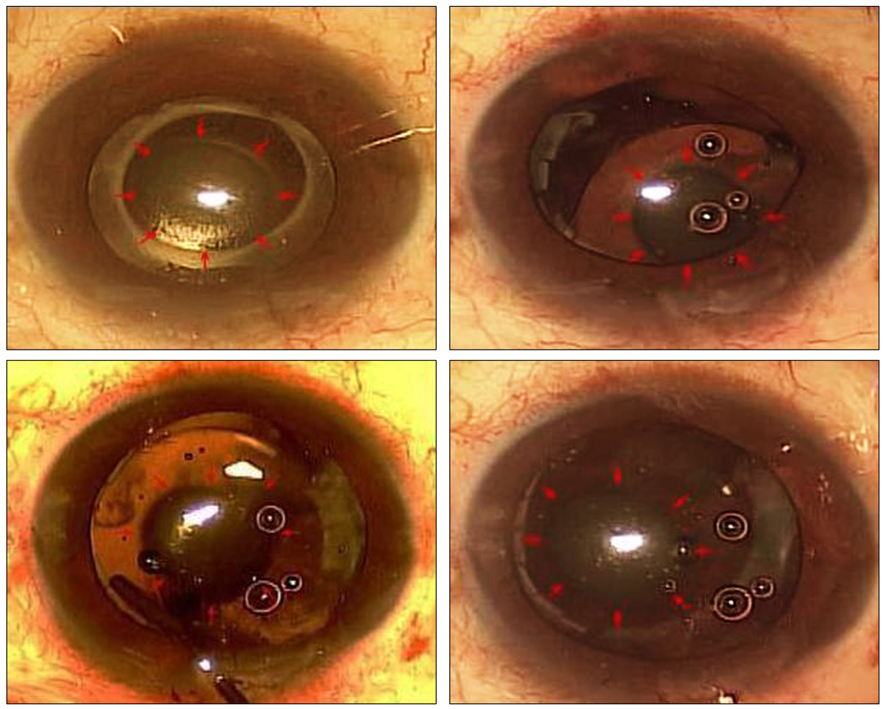Korean J Ophthalmol.
2010 Dec;24(6):371-373. 10.3341/kjo.2010.24.6.371.
Opacification of the Optic of an Akreos Adapt Intraocular Lens
- Affiliations
-
- 1Department of Ophthalmology, Keimyung University School of Medicine, Daegu, Korea. changsd@dsmc.or.kr
- KMID: 1769093
- DOI: http://doi.org/10.3341/kjo.2010.24.6.371
Abstract
- A 60-year-old diabetic patient transferred to our retina clinic for a regular follow-up for diabetic retinopathy. He had uneventful cataract surgery at the time of pars plana vitrectomy in the right eye due to diabetic retinopathy at a private ophthalmologic hospital. Six months after the surgery, neovascular glaucoma with hyphema developed in the right eye and an Ahmed valve was implanted at our hospital. Ten months after cataract surgery, we found opacification of the intraocular lens (IOL) which was causing significant visual disturbance. At the time, the best corrected visual acuity (BCVA) in the right eye was hand motion. The IOL was explanted 45 months after the operation. Five months after explantation, the BCVA was 0.06. Unfortunately, pathologic analysis was not performed. Patient-related factors such as an anterior chamber reaction caused by hyphema might have been responsible for the opacification. To our knowledge, there are no previous reports of opacification of the Akreos Adapt IOL.
Keyword
MeSH Terms
-
Cataract/complications/etiology
Cataract Extraction
Device Removal
Diabetic Retinopathy/surgery
Equipment Failure
Eyeglasses
Glaucoma, Neovascular/etiology
Humans
Hyphema/etiology
Lens Implantation, Intraocular
Lenses, Intraocular/*adverse effects
Male
Middle Aged
Postoperative Complications
Vision Disorders/*etiology
Visual Acuity
Vitrectomy/methods
Figure
Cited by 1 articles
-
Two Cases of Intraoperative Acute Opacification of Hydrophilic Intraocular Lens
Hyo Song Park, Yong Min Kim, Jong Yun Yang
J Korean Ophthalmol Soc. 2018;59(10):974-977. doi: 10.3341/jkos.2018.59.10.974.
Reference
-
1. Werner L, Apple DJ, Escobar-Gomez M, et al. Postoperative deposition of calcium on the surfaces of a hydrogel intraocular lens. Ophthalmology. 2000. 107:2179–2185.2. Pandey SK, Werner L, Apple DJ, Gravel JP. Calcium precipitation on the optical surfaces of a foldable intraocular lens: a clinicopathological correlation. Arch Ophthalmol. 2002. 120:391–393.3. Tehrani M, Mamalis N, Wallin T, et al. Late postoperative opacification of MemoryLens hydrophilic acrylic intraocular lenses: case series and review. J Cataract Refract Surg. 2004. 30:115–122.4. Neuhann IM, Werner L, Izak AM, et al. Late postoperative opacification of a hydrophilic acrylic (hydrogel) intraocular lens: a clinicopathological analysis of 106 explants. Ophthalmology. 2004. 111:2094–2101.5. Hunter B, Werner L, Memmen JE, Mamalis N. Postoperative localized opacification of the new MemoryLens design: analyses of an explant. J Cataract Refract Surg. 2005. 31:1836–1840.6. Werner L, Apple DJ, Kaskaloglu M, Pandey SK. Dense opacification of the optical component of a hydrophilic acrylic intraocular lens: a clinicopathological analysis of 9 explanted lenses. J Cataract Refract Surg. 2001. 27:1485–1492.7. Macky TA, Werner L, Soliman MM, et al. Opacification of two hydrophilic acrylic intraocular lenses 3 months after implantation. Ophthalmic Surg Lasers Imaging. 2003. 34:197–202.8. Frohn A, Dick HB, Augustin AJ, Grus FH. Late opacification of the foldable hydrophilic acrylic lens SC60B-OUV. Ophthalmology. 2001. 108:1999–2004.9. Izak AM, Werner L, Pandey SK, Apple DJ. Calcification of modern foldable hydrogel intraocular lens designs. Eye (Lond). 2003. 17:393–406.10. Werner L, Hunter B, Stevens S, et al. Role of silicon contamination on calcification of hydrophilic acrylic intraocular lenses. Am J Ophthalmol. 2006. 141:35–43.11. Werner L. Causes of intraocular lens opacification or discoloration. J Cataract Refract Surg. 2007. 33:713–726.12. Kim HG, Lee SH, Choi YJ. Late postoperative opacification of the foldable hydrophilic acrylic intraocular lens, ACRL-160. J Korean Ophthalmol Soc. 2003. 44:315–320.13. Hong JW, Roh IH, Bae SR. Opacification of hydrophilic acrylic intraocular lens. Korean J Optom Vis Sci. 2007. 6:68–71.14. Kotagiri AK, Nyunt KM, Fox P. Surface deposits on the optic of an Akreos Fit IOL. J Cataract Refract Surg. 2007. 33:1678–1679.15. Sher JH, Gooi P, Dubinski W, et al. Comparison of the incidence of opacification of Hydroview hydrogel intraocular lenses with the ophthalmic viscosurgical device used during surgery. J Cataract Refract Surg. 2008. 34:459–464.16. Ha MS, Kang BD, Myung NH, Chang MH. Postoperative deposition of calcium on the surface of a hydrophilic acrylic IOL in diabetic patients. J Korean Ophthalmol Soc. 2002. 43:375–380.17. Pombo C, Bokser L, Casabiell X, et al. Partial characterization of a putative new growth factor present in pathological human vitreous. Graefes Arch Clin Exp Ophthalmol. 1996. 234:155–163.
- Full Text Links
- Actions
-
Cited
- CITED
-
- Close
- Share
- Similar articles
-
- Comparison of Clinical Results Between Two Spherical Aberraion-Free Intraocular Lenses
- Posterior Capsule Opacification and Intraocular Lens Design with In-the-bag fixated Posterior Chamber Lens
- Two Cases of Intraoperative Acute Opacification of Hydrophilic Intraocular Lens
- Posterior Capsule Opacification and Intraocular Lens Design in Sulcus Fixated Posterior Chamber Lens
- Clinical Results of Single-Piece Hydrophilic IOL after Cataract Surgery


